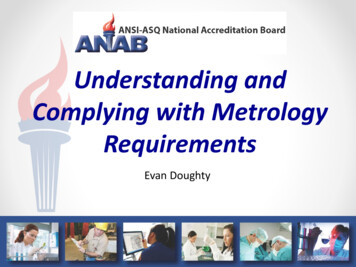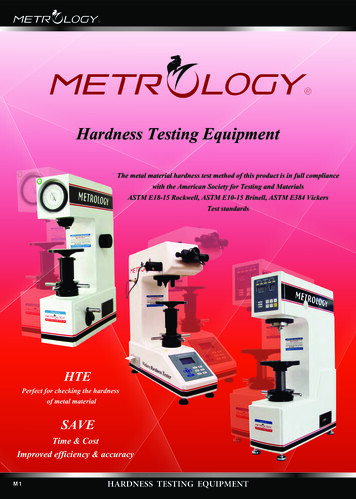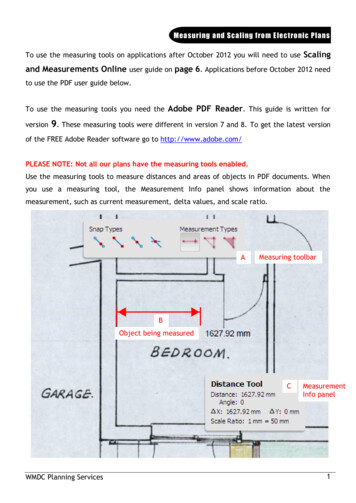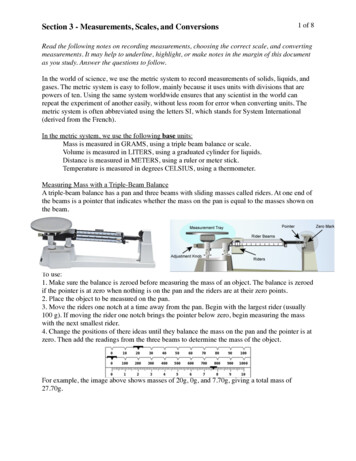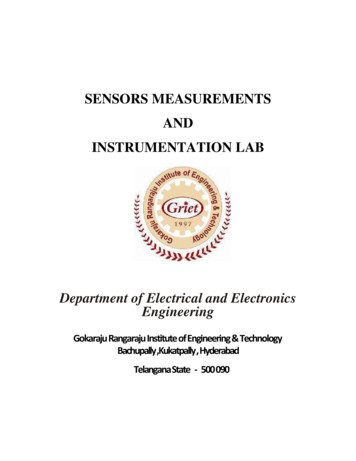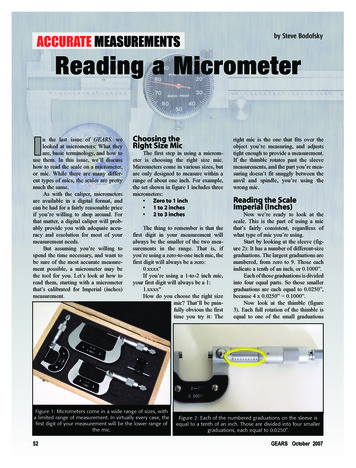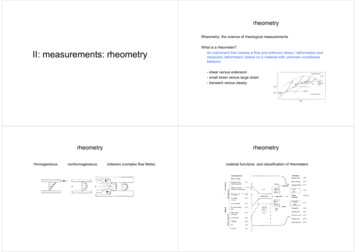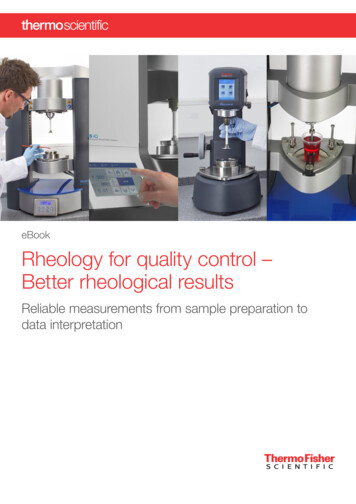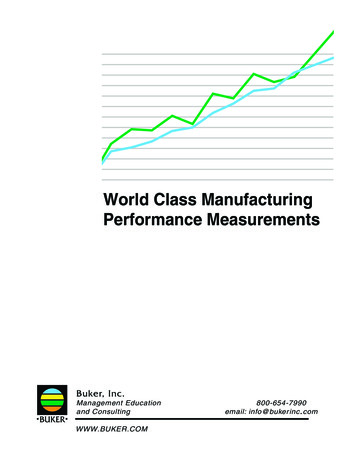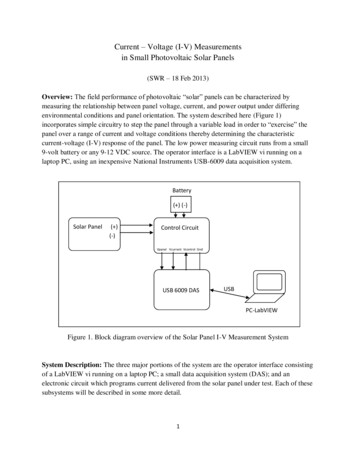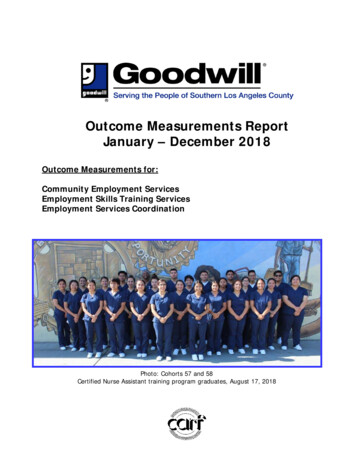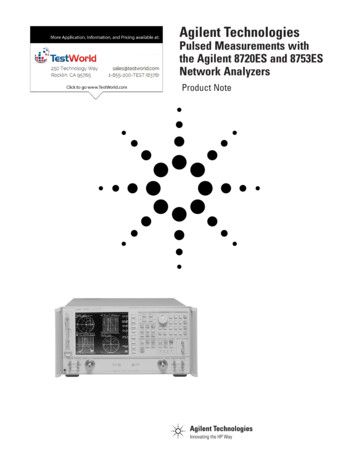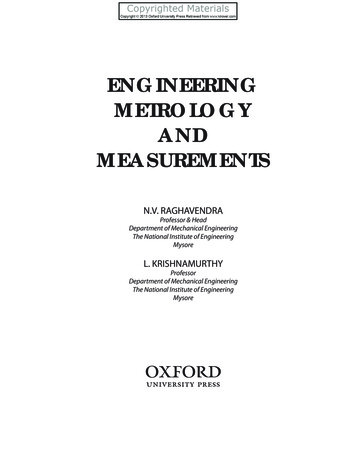
Transcription
ENGINEERINGMETROLOGYANDMEASUREMENTSN.V. RAGHAVENDRAProfessor & HeadDepartment of Mechanical EngineeringThe National Institute of EngineeringMysoreL. KRISHNAMURTHYProfessorDepartment of Mechanical EngineeringThe National Institute of EngineeringMysore
3Oxford University Press is a department of the University of Oxford.It furthers the University’s objective of excellence in research, scholarship,and education by publishing worldwide. Oxford is a registered trade mark ofOxford University Press in the UK and in certain other countries.Published in India byOxford University PressYMCA Library Building, 1 Jai Singh Road, New Delhi 110001, India Oxford University Press 2013The moral rights of the author/s have been asserted.First published in 2013All rights reserved. No part of this publication may be reproduced, stored ina retrieval system, or transmitted, in any form or by any means, without theprior permission in writing of Oxford University Press, or as expressly permittedby law, by licence, or under terms agreed with the appropriate reprographicsrights organization. Enquiries concerning reproduction outside the scope of theabove should be sent to the Rights Department, Oxford University Press, at theaddress above.You must not circulate this work in any other formand you must impose this same condition on any acquirer.ISBN-13: 978-0-19-808549-2ISBN-10: 0-19-808549-4Typeset in Timesby Trinity Designers & Typesetters, ChennaiPrinted in India by Tara Art Printers (P) Ltd, NoidaThird-party website addresses mentioned in this book are providedby Oxford University Press in good faith and for information only.Oxford University Press disclaims any responsibility for the material contained therein.
Dedicated to our revered guru and mentor,Dr T.R. Seetharam
INDEX 521About the AuthorsN.V. Raghavendra is Professor and Head, Department of Mechanical Engineering, the National Instituteof Engineering (NIE), Mysore. He has more than 25 years of teaching and research experience. A Ph Dholder from the Indian Institute of Science (IISc), his doctoral research area was on ‘Acquisition ofTechnological Capability and Economic Performance in Clusters’, done with an objective to understandthe major factors that influence acquisition of technological capability (especially in smaller firms) andalso recommend policy measures for their growth and sustenance. Dr Raghavendra was a member of theImplementation Committee of the prestigious VTU–Bosch Rexroth Centre of Automation Technology,Mysore. He has also served as the Special Officer of the VTU–Bosch Rexroth Centre, Mysore fromSeptember 2007 to December 2008 and Director of the NIE–Eicher Centre for Automobile Technology,NIE, from January 2011 to January 2013.L. Krishnamurthy is Professor, Department of Mechanical Engineering, the National Instituteof Engineering, Mysore. He has more than 25 years of teaching cum research experience. Prof.Krishnamurthy holds a doctoral degree from Kuvempu University, Karnataka. His research area was on‘Machinability Studies on Metal Matrix Hybrid Composites’. He co-investigates the research projecttitled ‘Characterization of Composite Materials and Application of Nanomaterials for SustainableEnergy’ sanctioned by Nano Mission, Department of Science and Technology, Government of India.
PrefaceThe origin of metrology can be traced to the Industrial Revolution, which began in WesternEurope and the United States in the beginning of the 19th century. This period saw a transitionfrom manual to mechanized production and the setting up of factories to manufacture ironand textiles. There was a paradigm shift from artisan-oriented production methods to massproduction. An artisan produced an article the same way a storage shelf is built in a closet—by trial and error till the parts fit. Mass production called for division of labour and precisedefinition of production tasks. Tasks became specialized, requiring skilled people who workedon only a portion of the job, but completed it quickly and efficiently. The workers’ wages weredetermined by a ‘piece-rate’ system. They were only paid for the good parts; thus it becamenecessary to define what a good part was. This led to the design of inspection gauges and theneed for an inspector who could decide whether a part was good or not. In 1913, Henry Ford,an American idustrialist, perfected the assembly line system to produce cars. In order to ensurequality as well as high production rates, new methods of inspection and quality control wereinitiated, which perhaps formed the basis of modern metrology.Engineering metrology deals with the applications of measurement science in manufacturingprocesses. It provides a means of assessing the suitability of measuring instruments, theircalibration, and the quality control of manufactured components. A product that is notmanufactured according to metrological specifications will have to incur heavy costs to complywith the specifications later. Any compromise in quality creates rapid negative sentiments inthe market and the cost of recovering the original market position would be quite high. Today,metrological error has a far greater impact on cost than in the past. Hence, an organization shouldstrive towards a zero-defect regime in order to survive in a highly competitive market. Ensuringthis aspect of manufacturing is the responsibility of a quality control engineer, who must becompletely familiar with the basics of measurement, standards and systems of measurement,tolerances, measuring instruments, and their limitations.The science of mechanical measurements has its roots in physics. It is an independentdomain of knowledge dealing with the measurement of various physical quantities such aspressure, temperature, force, and flow.ABOUT THE BOOKEngineering Metrology and Measurements is a core subject for mechanical, production, andallied disciplines in all the major universities in India. Although there are a few good booksavailable on metrology, the coverage of topics on mechanical measurements is either scanty orsuperficial, necessitating students to refer to different books on mechanical measurements. Thisbook provides a comprehensive coverage of both metrology and mechanical measurements.Divided into three parts, the first part of the book comprising Chapters 1–11, begins with acomprehensive outline of the field of engineering metrology and its importance in mechanicalengineering design and manufacturing. The basic concepts of engineering standards, limits,fits, and tolerances, for ensuring interchangeability of machine components are then discussed.
vi PREFACEThis is followed by a discussion on metrology of linear and angular measurements. Later inthe book, comparators, followed by the metrology of gears, screw threads, and surface finishmetrology are discussed. The chapter on miscellaneous metrology talks about laser-basedinstrumentation and coordinate measuring machines. The last chapter in this section featuresinspection methods and quality control.The second part of the book comprising Chapters 12–16 focuses on mechanical measurements.The coverage is restricted to measurement techniques and systems that are complementary toengineering metrology. The topics covered are the basics of transducers and the measurementof force, torque, strain, temperature, and pressure.The third part of the book comprising Chapter 17 details nanometrology techniquesand instrumentation. Nanotechnology has opened a new world of scientific research andapplications. India has also joined the bandwagon and today, we see a phenomenal investmentin the research and development of this discipline, both in the government and private sectors.There is abundant scope for pursuing higher studies both in India and abroad. We hope thissection on nanometrology will further stimulate the curiosity of the students and motivate themto take up higher studies in this new and interesting field.The book is designed to meet the needs of undergraduate students of mechanical engineeringand allied disciplines. The contents of this book have been chosen after careful perusal ofthe syllabi of the undergraduate (B.E./B. Tech) and diploma programmes in India. The topicsare explained lucidly and are supported by self-explanatory illustrations and sketches. Thefollowing are a few key features of the book.KEY FEATURES Covers both metrology and mechanical measurements in one volume Offers guidelines for the proper use and maintenance of important instruments, such asvernier callipers, autocollimators, slip gauges, and pyrometers Provides simple solved examples, numerical exercises in all relevant chapters, theoreticalreview questions, and multiple-choice questions with answers at the end of every chapter Introduces the principles of nanometrology, a topic that has emerged from the populardiscipline of nanotechnology, in an exclusive chapter, highlighting its applications in theproduction processes Includes an appendix containing 20 laboratory experiments with comprehensive procedures,observation templates, and model characteristics, with select experiments presentingphotographs of the actual instruments to gain a visual understanding of the equipment usedONLINE RESOURCESTo aid the faculty and students using this book, the companion website of this book ing-metrology-measurements/9780198085492provides the following resources:For instructors A solutions manual for the numerical exercises given in the book
PREFACE vii A complete chapter-wise PowerPoint presentation to aid classroom teachingFor students Two sets of model question papers to test students’ understanding of the subject, therebypreparing them for the end-semester examination.CONTENTS AND COVERAGEThe book is divided into three parts: Engineering Metrology (Chapters 1–11), MechanicalMeasurements (Chapters 12–16), and Nano Impact on Metrology (Chapter 17). A chapter-wisescheme of the book is presented here.Chapter 1 deals with the basic principles of engineering metrology. It gives an overview ofthe subject along with its importance. It also talks about general measurement, methods ofmeasurement, errors associated with any measurement, and the types of errors.Chapter 2 sets the standards of measurement. These standards acts as a reference point for thedimensional measurements.Chapter 3 presents the limits, fits, and tolerances in design and manufacturing. Anunderstanding of these concepts helps in the interchangeability of manufactured components.Chapter 4 discusses linear measurements that form one of the most important constituents ofmetrology. The chapter throws light on surface plates and V-blocks, over which the measurandis inspected. It discusses the scaled, vernier, and micrometer instruments in detail. The chapterends with a detailed explanation of slip gauges.Chapter 5 elaborates on angular measurements. The fact that not all measurands can bemeasured by linear methods stresses the significance of this topic. This chapter deals withdevices such as protractors, sine bars, angle gauges, spirit levels, and other optical instrumentsused for angular measurements.Chapter 6 aids in the comprehension of comparators. In several instances, a measurement maybe carried out on the basis of a comparison with the existing standards of measurements. Thischapter discusses the instruments that work on this common principle.Chapter 7 explains optical measurements and interferometry. Optical measurement providesa simple, accurate, and reliable means of carrying out inspection and measurements in theindustry. This chapter gives insights into some of the important instruments and techniquesthat are widely used. Interferometers, which use laser as a source, are also discussed in detail.Chapter 8 focuses on the metrological inspection of gears and screw threads. Gears are themain elements in a transmission system. Misalignment and gear runout will result in vibrations,chatter, noise, and loss of power. Therefore, one cannot understate the importance of precisemeasurement and inspection techniques for gears. Similarly, the geometric aspects of screwthreads are quite complex and hence, thread gauging is an integral part of a unified threadgauging system.
viii PREFACEChapter 9 analyses the metrology of surface finish. Two apparently flat contacting surfacesare assumed to be in perfect contact throughout the area of contact. However, in reality, thereare peaks and valleys between surface contacts. Since mechanical engineering is primarilyconcerned with machines and moving parts that are designed to precisely fit with each other,surface metrology has become an important topic in engineering metrology.Chapter 10 comprises miscellaneous metrology, which details certain measurement principlesand techniques that cannot be classified under any of the aforementioned dimensionalmeasurements. Coordinate measuring machines (CMM), machine tool test alignment,automated inspection, and machine vision form the core of this chapter.Chapter 11 lays emphasis on inspection and quality control. Inspection is the scientificexamination of work parts to ensure adherence to dimensional accuracy, surface texture,and other related attributes. This chapter encompasses the basic functions of inspection andstatistical quality control—total quality management (TQM) and six sigma—the customercentric approaches towards achieving high quality of products, processes, and delivery.Chapter 12 helps in understanding mechanical measurements. Mechanical measurements are(physical) quantity measurements unlike the dimensional measurements discussed in Chapters1–11.Chapter 13 explains the principle and working of transducers. Transducers are generally definedas devices that transform physical quantities in the form of input signals into correspondingelectrical output signals. Since many of the measurement principles learnt in earlier chaptersrequire a transducer to transmit the obtained signal into an electrical form, the study oftransducers is inevitable.Chapter 14 elucidates the physical quantities of measurement: force, torque, and strain.Chapter 15 illustrates the concept of temperature measurements—the principles involvedin temperature measurement and devices such as resistance temperature detector (RTD),thermocouple, liquid in glass thermometer, bimetallic strip thermometers, and pyrometers.Chapter 16 defines yet another important physical quantity, pressure. It helps us in gettingacquainted with instruments such as manometers, elastic transducers, and vacuum and highpressure measurement systems.Chapter 17 helps us appreciate the applications of nanotechnology in metrology. It explainsthe basic principles of nanotechnology and its application in the manufacturing of nanoscaleelements that are made to perfection.Appendix A introduces the universal measuring machine.Appendix B simplifies the theory of flow measurement. Although a broader subset of mechanicalmeasurements, flow measurement is an independent field of study. Students are introduced tothis field in a typical course on fluid mechanics. Here we have tried to present only the basicsof flow measurement with a synopsis of measurement devices such as the orifice meter, venturimeter, pitot tube, and rotameter.
PREFACE ixAppendix C comprises 20 laboratory experiments with photographs of some of the equipmentused in measurement. The appendix also provides a step-by-step procedure to conduct theexperiments and an observation of results.Appendix D presents the control chart associated with statistical quality control. These valueshelp understand certain problems discussed in Chapter 11.ACKNOWLEDGEMENTSWe attribute our efforts for completing this book to Dr T.R. Seetharam and Dr G.L. Shekar,who have inspired us and shaped our careers. Dr. Seetharam, Professor (retired) in MechanicalEngineering and former Principal, National Institute of Engineering (NIE), Mysore, is anembodiment of scholarship and simplicity. He has motivated thousands of students, whoare now in noteworthy positions in organizations all over the world. He mentored us duringour formative years at the NIE and instilled in us the spirit to strive for excellence. Dr G.L.Shekar, the present Principal of NIE has been a friend, philosopher, and guide. He is a bundleof unlimited energy and has initiated a large number of research and industry-related projects atthe NIE. We are happy to be associated with many of these projects, which have broadened ourhorizon of knowledge and provided a highly stimulating work environment.We thank our college management, colleagues, and students, who encouraged us to work onthis book. Special thanks to our esteemed colleagues, Dr B.K. Sridhara, Dr T.N. Shridhar, and DrM.V. Achutha, for their valuable suggestions and continuous encouragement. We acknowledgethe contributions of our former colleagues, Mr Manil Raj and Mr N.S. Prasad, in the preparationof the laboratory experiments provided as an appendix in the book. Special thanks to Mr K.Chandrashekar, Scientist B, Centre for Nanotechnology, NIE, for sourcing a large number ofe-books on nanotechnology. Ms Pooja K., Software Engineer, Delphi Automotive Systems Pvt.Ltd, Bangalore, provided useful inputs for key chapters in Part II of the book and we thank herfor the same.We are extremely grateful to our families, who graciously accepted our inability to attend tofamily chores during the course of writing this book, and especially for their extended warmthand encouragement. Without their support, we would not have been able to venture into writingthis book.Last, but not the least, we express our heartfelt thanks to the editorial team at the OxfordUniversity Press, who guided us through this project.We eagerly look forward to your feedback. You can reach us by e-mail at raghu62.nie@gmail.com and kitty nie@yahoo.co.inN.V. RaghavendraL. Krishnamurthy
Brief ContentsPreface vFeatures of the Book xDetailed Contents xiiiPART I: ENGINEERING METROLOGY1.2.3.4.5.6.7.8.9.10.11.Basic Principles of Engineering MetrologyStandards of MeasurementLimits, Fits, and TolerancesLinear MeasurementAngular MeasurementComparatorsOptical Measurement and InterferometryMetrology of Gears and Screw ThreadsMetrology of Surface FinishMiscellaneous MetrologyInspection and Quality Control13203980118141167188217231260PART II: MECHANICAL rement SystemsTransducersMeasurement of Force, Torque, and StrainMeasurement of TemperaturePressure MeasurementsPART III: NANO IMPACT ON METROLOGY41117. Nanometrology413Appendix A: Universal Measuring Machine 439Appendix B: Flow Measurement 440Appendix C: Laboratory Experiments 445Appendix D: Control Chart Factors 509References 511Index 513About the Authors 521
Detailed ContentsPreface vFeatures of the Book xBrief Contents xiiPART I: ENGINEERING METROLOGY1. Basic Principles of ology4Need for Inspection5Accuracy and Precision71.4.1 Accuracy and Cost 91.5 Objectives of Metrology andMeasurements91.6 General Measurement Concepts101.6.1 Calibration of MeasuringInstruments 101.7 Errors in Measurements111.7.1 Systematic or ControllableErrors 121.7.2 Random Errors 141.8 Methods of Measurement152. Standards of Measurement202.1 Introduction202.2 Standards and their Roles202.3 Evolution of Standards212.4 National Physical Laboratory232.5 Material Standard232.5.1 Yard 242.5.2 Metre 252.5.3 Disadvantages of MaterialStandards 252.6 Wavelength Standard252.6.1 Modern Metre 262.7 Subdivisions of Standards262.8 Line and End Measurements282.8.1 Characteristics of LineStandards 282.8.2 Characteristics of EndStandards 2912.8.3 Transfer from Line Standard toEnd Standard 302.92.102.112.12Brookes Level ComparatorDisplacement MethodCalibration of End BarsNumerical Examples3. Limits, Fits, and Tolerances31323333393.1 Introduction393.2 Principle of Interchangeability413.2.1 Selective Assembly Approach 423.3 Tolerances433.3.1 Computer-aided Modelling 433.3.2 Manufacturing Cost and WorkTolerance 443.3.3 Classification of Tolerance 443.4 Maximum and Minimum MetalConditions483.5 Fits483.5.1 Allowance 503.5.2 Hole Basis and Shaft BasisSystems 513.5.3 Numerical Examples 523.6 System of Limits and Fits563.6.1 General Terminology 613.6.2 Limit Gauging 633.6.3 Classification of Gauges 653.6.4 Taylor’s Principle 663.6.5 Important Points for GaugeDesign 673.6.6 Material for Gauges 683.6.7 Gauge Tolerance (Gauge Maker’sTolerance) 683.6.8 Wear Allowance 693.6.9 Methods of Tolerance Specificationon Gauges 69
xiv DETAILED CONTENTS3.6.10 Numerical Examples 713.7 Plain Plug Gauges3.8 Snap Gauges4. Linear Measurement804.1 Introduction804.2 Design of Linear MeasurementInstruments814.3 Surface Plate824.4 V-blocks854.5 Graduated Scales854.5.1 Errors in Measurements 864.6 Scaled Instruments884.6.1 Depth Gauge 884.6.2 Combination Set 894.6.3 Callipers 914.7 Vernier Instruments944.7.1 Vernier Calliper 954.7.2 Vernier Depth Gauge 984.7.3 Vernier Height Gauge 994.8 Micrometer Instruments994.8.1 Outside Micrometer 1004.8.2 Vernier Micrometer 1034.8.3 Digital Micrometer 1044.8.4 Inside Micrometer Calliper 1054.8.5 Inside Micrometer 1054.8.6 Depth Micrometer 1064.8.7 Floating CarriageMicrometer 1074.9 Slip Gauges1074.9.1 Gauge Block Shapes, Grades, andSizes 1094.9.2 Wringing of Slip Gauges 1104.9.3 Manufacture of Slip Gauges 1124.9.4 Calibration of Slip Gauges 1124.10 Numerical Examples1135. Angular Measurement5.3.3 Sine Blocks, Sine Plates, and SineTables 1255.3.4 Sine Centre 12674751185.1 Introduction1185.2 Protractor1195.2.1 Universal Bevel Protractor 1195.2.2 Optical Bevel Protractor 1225.3 Sine Bar1235.3.1 Setting the Sine Bars to DesiredAngles 1245.3.2 Measuring Unknown Angles withSine Bar 1255.4 Angle Gauges1265.4.1 Uses 1285.4.2 Manufacture and Calibration 1295.4.3 True Square 1305.5 Spirit Level1305.5.1 Clinometer 1325.6 Optical Instruments for AngularMeasurement1325.6.1 Autocollimator 1335.6.2 Autocollimator Applications 1355.6.3 Angle Dekkor 1376. l Requirements142Classification of Comparators143Mechanical Comparators1436.4.1 Dial Indicator 1436.4.2 Johansson Mikrokator 1476.4.3 Sigma Comparator 1486.5 Mechanical–Optical Comparator 1486.5.1 Zeiss Ultra-optimeter 1496.5.2 Optical Projector 1506.6 Electrical Comparators1516.6.1 Linear Variable DifferentialTransformer 1526.6.2 Electronic Comparator 1536.7 Pneumatic Comparators 1566.7.1 Free Flow Air Gauge 1576.7.2 Back Pressure Gauge 1596.7.3 Solex Pneumatic Gauge 1616.7.4 Applications of PneumaticComparators 1627. Optical Measurement andInterferometry1677.1 Introduction1677.2 Optical Measurement Techniques 1687.2.1 Tool Maker’s Microscope 1687.2.2 Profile Projector 1717.2.3 Optical Squares 1717.3 Optical Interference1727.4 Interferometry1747.4.1 Optical Flats 174
DETAILED CONTENTS xv7.5 Interferometers7.5.1 NPL Flatness Interferometer7.5.2 Pitter–NPL GaugeInterferometer 1797.5.3 Laser Interferometers 1807.6 Scales, Gratings, and Reticles7.6.1 Scales 1827.6.2 Gratings 1827.6.3 Reticles 1827.7 Numerical Examples8. Metrology of Gears andScrew Threads1771771811831888.1 Introduction1888.2 Gear Terminology1898.2.1 Types of Gears 1898.2.2 Line of Action andPressure Angle 1928.3 Errors in Spur Gears1928.4 Measurement of Gear Elements 1938.4.1 Measurement of Runout 1938.4.2 Measurement of Pitch 1948.4.3 Measurement of Profile 1958.4.4 Measurement of Lead 1978.4.5 Measurement of Backlash 1978.4.6 Measurement of ToothThickness 1988.5 Composite Method ofGear Inspection2018.5.1 Parkinson Gear Tester 2018.6 Measurement of Screw Threads 2028.7 Screw Thread Terminology 2038.8 Measurement of ScrewThread Elements2048.8.1 Measurement of MajorDiameter 2058.8.2 Measurement of MinorDiameter 2058.8.3 Measurement of EffectiveDiameter 2068.8.4 Measurement of Pitch 2098.9 Thread Gauges2108.10 Numerical Examples2129. Metrology of Surface Finish9.1 Introduction9.2 Surface Metrology Concepts2172172189.3 Terminology2199.4 Analysis of Surface Traces 2209.4.1 Ten-point Height AverageValue 2209.4.2 Root Mean Square Value 2209.4.3 Centre Line Average Value 2209.5 Specification of Surface TextureCharacteristics2219.6 Methods of MeasuringSurface Finish2229.7 Stylus System of Measurement 2239.7.1 Stylus and Datum 2239.8 Stylus Probe Instruments2249.8.1 Tomlinson Surface Meter 2249.8.2 Taylor–Hobson Talysurf 2259.8.3 Profilometer 2259.9 Wavelength, Frequency,and Cut-off2269.9.1 Cut-off Wavelength 2269.10 Other Methods for MeasuringSurface Roughness2279.10.1 Pneumatic Method 2279.10.2 Light InterferenceMicroscopes 2279.10.3 Mecrin Instrument 22710. Miscellaneous Metrology23110.1 Introduction23110.2 Precision Instrumentation Based onLaser Principles23210.3 Coordinate Measuring Machines 23310.3.1 Structure 23410.3.2 Modes of Operation 23510.3.3 Probe 23510.3.4 Operation 23610.3.5 Major Applications 23810.4 Machine Tool Metrology23810.4.1 Straightness, Flatness, Parallelism,Squareness, Roundness,Cylindricity, and Runout 23910.4.2 Acceptance Tests for MachineTools 24410.5 Automated Inspection25110.5.1 Flexible Inspection System 25310.6 Machine Vision25310.6.1 Stages of Machine Vision 253
xvi DETAILED CONTENTS10.6.2 Applications of Machine Vision inInspection 25611. Inspection and Quality Control26011.1 Introduction26011.2 Inspection26111.3 Specifying Limits of Variability 26211.4 Dimensions and Tolerances26411.5 Selection of Gauging Equipment 26511.6 Gauge Control26611.7 Quality Control and QualityAssurance26711.8 Statistical Quality Control26911.8.1 Process Variability 26911.8.2 Importance of Sampling 27011.8.3 Statistical Quality Control byAttributes 27211.8.4 Statistical Quality Control byVariables 27311.9 Total Quality Management27811.9.1 Customer Focus 27911.9.2 Continuous Improvement 28011.9.3 Employee Empowerment 28011.9.4 Use of Quality Tools 28111.9.5 Product Design 28211.9.6 Process Management 28211.9.7 Managing Supplier Quality 28311.10 Six Sigma28411.10.1 Six Sigma Approach 28511.10.2 Training for Six Sigma 28611.11 Quality Standards28611.11.1 Quality Management Principles ofISO 9000 28711.11.2 Implementation ofISO Standards 28911.12 Numerical Examples289Annexure I—Control Chart Factors 301PART II: MECHANICAL MEASUREMENTS12. Measurement Systems30512.1 Introduction30512.2 Some Basic Definitions30512.2.1 Hysteresis in MeasurementSystems 30612.2.2 Linearity in MeasurementSystems 30612.2.3 Resolution of MeasuringInstruments 30712.2.4 Threshold 30812.2.5 Drift 30812.2.6 Zero Stability 30812.2.7 Loading Effects 30812.2.8 System Response 30812.3 Functional Elements ofMeasurement Systems30912.4 Primary Detector–Transducer Stage31012.5 Intermediate Modifying Stage31112.6 Output or Terminating Stage31213. Transducers13.1 Introduction13.2 Transfer Efficiency13.3 Classification of Transducers31531531531630313.3.1 Primary and SecondaryTransducers 31613.3.2 Based on Principle ofTransduction 31713.3.3 Active and PassiveTransducers 31813.3.4 Analog and DigitalTransducers 31813.3.5 Direct and InverseTransducers 31813.3.6 Null- and Deflection-typeTransducers 31913.4 Quality Attributes for Transducers 32013.5 Intermediate Modifying Devices 32013.5.1 Inherent Problems in MechanicalSystems 32113.5.2 Kinematic Linearity 32213.5.3 Mechanical Amplification 32213.5.3 Reflected FrictionalAmplification 32213.5.4 Reflected InertialAmplification 32313.5.5 Amplification of Backlash andElastic Deformation 323
DETAILED CONTENTS xvii13.5.6 Tolerance Problems 32413.5.7 Temperature Problems 32413.6 Advantages of Electrical IntermediateModifying Devices32513.7 Electrical Intermediate ModifyingDevices32613.7.1 Input Circuitry 32613.7.2 Simple Current-sensitiveCircuits 32613.7.3 Ballast Circuit 32713.7.4 Electronic Amplifiers 32913.7.5 Telemetry 33013.8 Terminating Devices33213.8.1 Meter Indicators 33213.8.2 Mechanical Counters 33413.8.3 Cathode Ray Oscilloscope 33413.8.4 Oscillographs 33713.8.5 XY Plotters 33814. Measurement of Force, Torque,and Strain34114.1 Introduction34114.2 Measurement of Force34214.2.1 Direct Methods 34214.3 Elastic Members34514.3.1 Load Cells 34514.3.2 Cantilever Beams 34714.3.3 Proving Rings 34714.3.4 Differential Transformers 34814.4 Measurement of Torque34814.4.1 Torsion-bar Dynamometer 34914.4.2 Servo-controlledDynamometer 34914.4.3 Absorption Dynamometer 35014.5 Measurement of Strain35114.5.1 Mechanical Strain Gauges 35214.5.2 Electrical Strain Gauges 35214.6 Strain Gauge Materials35514.7 Backing or Carrier Materials35614.8 Adhesives35714.9 Protective Coatings35714.10 Bonding of Gauges35814.11 Gauge Factor35814.12 Theory of Strain Gauges35814.13 Methods of Strain Measurement 35914.14 Strain Gauge Bridge Arrangement 36014.15 Temperature Compensation inStrain Gauges36114.15.1 Adjacent-arm CompensatingGauge 36114.15.2 Self-temperatureCompensation 36115. Measurement of Temperature36515.1 Introduction36515.2 Methods of MeasuringTemperature36615.3 Thermocouples36715.3.1 Laws of Thermocouples 36815.3.2 Thermocouple Materials 36915.3.3 Advantages and Disadvantages ofThermocouple Materials 37015.3.4 Thermopiles 37015.4 Resistance Temperature Detectors 37115.5 Thermistors37415.6 Liquid-in-glass Thermometers37515.7 Pressure Thermometers37615.8 Bimetallic Strip Thermometers37715.9 Pyrometry37815.9.1 Total Radiation Pyrometer 37915.9.2 Optical Pyrometer 38015.9.3 Fibre-optic Pyrometers 38215.9.4 Infrared Thermometers 38216. Pressure Measurements38716.1 Introduction38716.2 Pressure Measurement Scales38816.3 Methods of PressureMeasurement38816.3.1 Static Pressure Measurement 38916.3.2 Classification of PressureMeasuring Devices 39016.3.3 Manometers for PressureMeasurement 39016.4 Ring Balance39316.5 Inverted Bell Manometer39316.6 Elastic Transducers39416.7 Electrical Pressure Transducers 39616.7.1 Resistance-type Transducer 39716.7.2 Potentiometer Devices 39716.7.3 Inductive-type Transducer 39816.7.4 Capacitive-type Transducer
The book is divided into three parts: Engineering Metrology (Chapters 1–11), Mechanical Measurements (Chapters 12–16), and Nano Impact on Metrology (Chapter 17). A chapter-wise scheme of the book is presented here. Chapter 1 deals with the basic principles of engineering metrology. It gi
